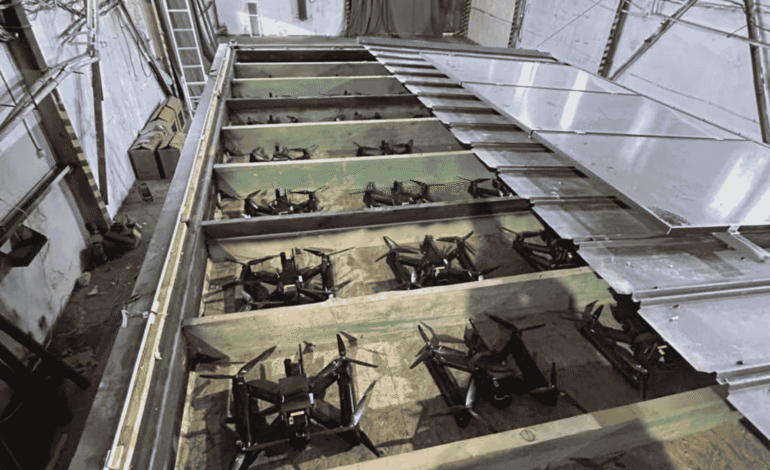Ukraine Strikes Russian Bombers in Siberia with Drones

As the war in Ukraine stretches into its third year, the nature of combat has evolved significantly. What began as a conventional land conflict has become a dynamic battlefield shaped by technological innovation, asymmetric tactics, and strategic sabotage. The latest and most daring example of this transformation came as Ukraine launched a large-scale drone strike deep inside Russian territory, destroying over 40 military aircraft at airfields in Siberia. The operation, reportedly overseen by President Volodymyr Zelenskyy himself, marks the most damaging drone assault by Ukraine to date.
The timing of this attack is particularly significant. It occurred just hours before planned peace talks in Istanbul, signaling a potent message of strength from Kyiv. While Russia has retaliated with a barrage of drones and missiles on Ukrainian cities, Ukraine’s surprise move indicates a major escalation and an impressive show of operational prowess that may reshape the course of negotiations.
The Operation: Codenamed “Spiderweb”
According to Ukrainian intelligence sources, the operation — known as “Spiderweb” — was in preparation for more than 18 months. This was not a sudden offensive but a meticulously organized campaign, combining stealth, patience, and innovative logistics. The Ukrainian Security Service (SBU) revealed that drones had been smuggled into Russian territory piece by piece and assembled in concealed wooden sheds.
These sheds, built to look like typical Russian structures with metal roofing, were loaded onto trucks and parked near four separate military airfields. The sheds featured remotely controlled roof panels that lifted off just before the drones launched, allowing them to emerge unseen and strike their targets with precision. Ukraine said that 117 drones were used during the attack, each operated remotely by Ukrainian personnel stationed across three Russian time zones.
The ingenuity behind the operation highlights Ukraine’s commitment to countering Russia’s military superiority using asymmetrical tactics. The goal was not just to destroy aircraft but to instill a sense of vulnerability deep within Russian territory, far from the frontline.
Targeted Sites and Damage Assessment
The drone strikes reportedly struck four Russian airbases, including Belaya airbase in Irkutsk oblast — more than 2,500 miles from Ukraine. These facilities house some of Russia’s most advanced strategic bombers, including the Tu-95 and Tu-22 models. The Tu-95, originally developed for nuclear warfare, is now used to launch cruise missiles against Ukrainian cities.
Video footage from the aftermath showed several massive bombers engulfed in flames. Explosions lit up the night sky, while satellite and drone imagery confirmed extensive damage. Ukrainian media claimed the attack destroyed aircraft worth over $7 billion. If this estimate is verified, the strike could go down as Ukraine’s most economically damaging assault on Russia’s military infrastructure since the war began.
The Ukrainian president praised the operation in a public address, highlighting the sophistication of its planning and execution. “We had been preparing the operation for more than a year and a half. Planning, organisation, and all the details were perfectly prepared. I can say for sure that this is a completely unique operation,” said Zelenskyy.
Russia Responds with Drone Barrages and Rail Sabotage
The Russian Defence Ministry acknowledged that several aircraft had “caught fire” and confirmed attacks at airbases in both the Murmansk and Irkutsk regions. Authorities downplayed the casualties, saying none had occurred, and added that several individuals suspected of aiding the strike were arrested. However, social media videos and commentary from Russian military sources painted a grim picture, with multiple planes ablaze and widespread panic among personnel.
In response, Russia intensified its drone and missile campaign on Ukrainian infrastructure. On the night following the drone strikes, Ukraine reported the largest aerial assault of the war thus far, with 472 drones launched by Russian forces, alongside seven missile attacks. Ukrainian authorities confirmed the death of at least 12 service members and more than 60 injuries following a missile strike on a military training facility.
Simultaneously, Russia suffered internal sabotage incidents. Two key railway bridges in the Kursk and Bryansk regions were destroyed in separate explosions, derailing trains and killing seven people. While no party claimed responsibility, Russian investigators labeled the events as “acts of terrorism” and blamed foreign interference. Moscow’s vast railway network has long been a target for Ukrainian sabotage efforts, given its role in transporting troops and ammunition.
The Role of Ukraine’s Domestic Intelligence Agency
Ukraine’s SBU, known for its covert operations, played a central role in executing the drone campaign. In a rare public disclosure, it released photographs showing the drones used in the mission — compact, quadcopter models stacked in an industrial facility. The images also displayed the wooden launch sheds with removed roof panels and drones in launching position.
According to the SBU, the drones were concealed near the airfields for months, lying dormant until the launch signal was given. Several were remotely operated by Ukrainian agents embedded in Russia, who were extracted back to safety shortly before the operation began. Their withdrawal without detection further underscores the tactical finesse involved in the mission.
Mash, a Russian Telegram channel with known links to state security, released footage allegedly showing locals in Irkutsk attempting to stop drones from launching by climbing onto trucks and sheds. This reactive approach suggests that Russian defense systems were caught completely off guard.
Peace Talks in Istanbul: Tense Timing and Political Stakes
Just hours after the attack, Ukraine confirmed it would send a delegation to Istanbul for renewed peace negotiations. The decision followed initial hesitation from Kyiv, which had previously expressed doubt about Moscow’s sincerity. The Ukrainian team, led by Defense Minister Rustem Umerov, is expected to propose terms for a sustainable ceasefire.
According to leaked drafts obtained by Reuters, Ukraine’s conditions include the return of abducted children, an unconditional ceasefire, and no international recognition of Russian claims over occupied territories. Kyiv has also demanded that no future agreements limit Ukraine’s ability to strengthen its military.
President Zelenskyy emphasized that while Ukraine seeks peace, it will not compromise its sovereignty. “I have defined our position before the Monday meeting in Istanbul. Our priorities remain a complete and unconditional ceasefire, the return of prisoners and abducted children,” he wrote on social media.
On the other side, Russian President Vladimir Putin had earlier stated that peace was contingent upon Ukraine renouncing NATO membership and withdrawing from four regions currently occupied by Russian forces. These opposing demands highlight the deep divide between the nations and suggest that talks may be long and arduous.
Strategic Implications of the Drone Offensive
Ukraine’s drone attack is more than a tactical success; it sends a strategic message to both domestic and international audiences. It proves that Ukraine has the capability to hit Russia where it least expects — far beyond the frontlines, into the heart of its military infrastructure. This disrupts the perception of Russia’s territorial security and undermines its military morale.
The operation also reflects the evolution of drone warfare. Ukraine has rapidly developed a sophisticated drone fleet, with some models reportedly having a range of up to 3,000 kilometers. This shift from defensive to offensive drone use marks a major turning point in how modern wars are conducted.
Moreover, it compels NATO and Western allies to reevaluate their support strategies. As Ukraine demonstrates its ability to self-innovate and strike deep into Russian territory, allies may feel more confident in providing advanced weaponry and intelligence.
International Reaction and Geopolitical Context
The United States, under President Donald Trump, has increased pressure on both Kyiv and Moscow to reach a resolution. Trump has warned that without progress toward peace, U.S. support could dwindle, leaving Ukraine more reliant on European aid. This stance adds urgency to the negotiations in Istanbul and may influence Ukraine’s approach to compromise.
The European Union, meanwhile, has reiterated its full support for Ukraine’s sovereignty and right to defend itself. German and French officials praised the tactical sophistication of the drone operation while urging both parties to engage in genuine diplomacy.
As the war enters a new and uncertain phase, Ukraine’s drone strike in Siberia may be remembered as a pivotal moment, not just in military terms, but as a demonstration of strategic resilience and innovation in the face of overwhelming odds.








1 Comment
[…] a prominent place on the agenda. Discussions include Ukraine’s recovery, Western sanctions against Russia, and the future of Ukrainian sovereignty—all while global leaders assess broader energy security […]
Comments are closed.